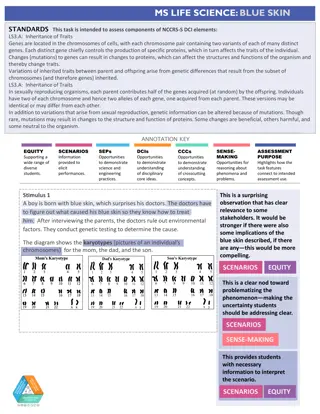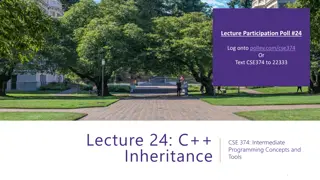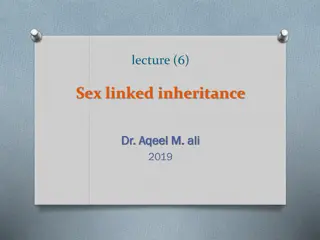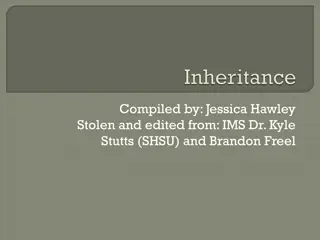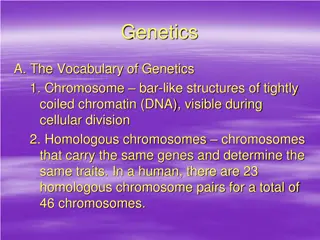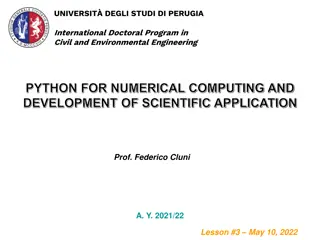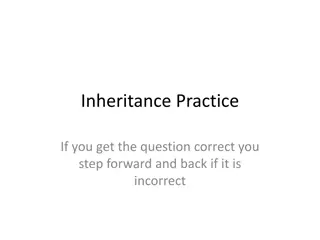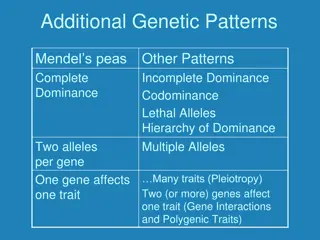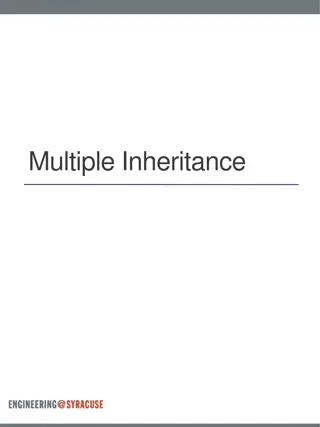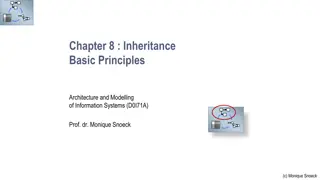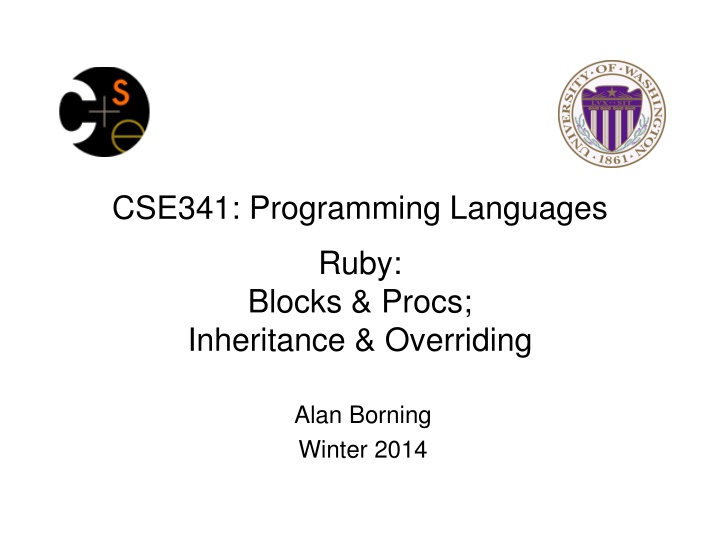
Ruby's Approach to Blocks, Procs, Inheritance, and Overriding
Explore Ruby's unique features such as blocks, closures, and inheritance in this insightful lecture from Winter 2014. Discover how Ruby handles almost-closures, inheritance, and the essence of object-oriented programming. Delve into the usage of blocks, iterators, and the peculiarities that make Ruby stand out among other programming languages.
Download Presentation

Please find below an Image/Link to download the presentation.
The content on the website is provided AS IS for your information and personal use only. It may not be sold, licensed, or shared on other websites without obtaining consent from the author. If you encounter any issues during the download, it is possible that the publisher has removed the file from their server.
You are allowed to download the files provided on this website for personal or commercial use, subject to the condition that they are used lawfully. All files are the property of their respective owners.
The content on the website is provided AS IS for your information and personal use only. It may not be sold, licensed, or shared on other websites without obtaining consent from the author.
E N D
Presentation Transcript
CSE341: Programming Languages Ruby: Blocks & Procs; Inheritance & Overriding Alan Borning Winter 2014
This lecture Two separate topics Ruby's approach to almost-closures (blocks) and closures (Procs) Convenient to use; unusual approach Used throughout large standard library Explicit loops rare Instead of a loop, go find a useful iterator Subclasses, inheritance, and overriding The essence of OOP Not unlike in Java, but worth studying from PL perspective and in a more dynamic language Winter 2014 CSE341: Programming Languages 2
Blocks Blocks are probably Ruby's strangest feature compared to other PLs Normal: easy way to pass anonymous functions for all the reasons we have been studying Normal: Blocks can take 0 or more arguments Strange: Can send 0 or 1 block with any message send Strange: Callee does not have a name for the block Calls it with yield, yield 42, yield (3,5), etc. Can ask block_given? but rarely used in practice (usually assume a block is given if expected, or that a block's presence is implied by other arguments) Winter 2014 CSE341: Programming Languages 3
Examples Rampant use of blocks in standard library Classes define iterators; don't write your own loops Most of these examples happen to have 0 "regular" arguments 3.times { puts "hi" } [4,6,8].each { puts "hi" } [4,6,8].each { |x| puts x * 2 } [4,6,8].map { |x| x * 2 } [4,6,8].any? { |x| x > 7 } # block optional [4,6,8].inject(foo) {|acc,elt| } Easy to write your own methods that use blocks def silly a (yield a) + (yield 42) end x.silly 5 { |b| b*2 } Winter 2014 CSE341: Programming Languages 4
Blocks are "second-class" All a method can do with a block is yield to it (i.e., call it) Can't return it, store it in an object (e.g., for a callback), etc. But can also turn blocks into real closures (next slide) But one block can call another block via yield From example MyList class in blocks.rb (though better in Ruby to use arrays as lists than define your own) def map if @tail.nil? MyList.new(yield(@head), nil) else MyList.new(yield(@head), @tail.map {|x| yield x}) end end Winter 2014 CSE341: Programming Languages 5
First-class closures Implicit block arguments and yield is often sufficient But when you want a closure you can return, store, etc.: The built-in Proc class lambda method of Object takes a block and makes a Proc Also can do it with "& arg (shown in block_proc.rb) Instances of Proc have a method call def map_p proc if @tail.nil? MyList.new(proc.call(@head), nil) else MyList.new(proc.call(@head), @tail.map proc) end end xs.map_p (lambda{|x| }) Winter 2014 CSE341: Programming Languages 6
Subclassing A class definition has a superclass (Object if not specified) class ColorPoint < Point The superclass affects the class definition: Class inherits all method definitions from superclass But class can override method definitions as desired Unlike Java: No such thing as "inheriting fields" since all objects create instance variables by assigning to them Subclassing has nothing to do with a (non-existent) type system: can still pass any object to any method Winter 2014 CSE341: Programming Languages 7
Example (to be continued) class Point attr_reader :x, :y attr_writer :x, :y def initialize(x,y) @x = x @y = y end def distFromOrigin # direct field access Math.sqrt(@x*@x + @y*@y) end def distFromOrigin2 # use getters Math.sqrt(x*x + y*y) end end class ColorPoint < Point attr_reader :color attr_writer :color def initialize(x,y,c) super(x,y) @color = c end end Winter 2014 CSE341: Programming Languages 8
An object has a class p = Point.new(0,0) cp = ColorPoint.new(0,0,"red") p.class # Point p.class.superclass # Object cp.class # ColorPoint cp.class.superclass # Point cp.class.superclass.superclass # Object cp.is_a? Point # true cp.instance_of? Point # false cp.is_a? ColorPoint # true cp.instance_of? ColorPoint # true Using these methods is usually non-OOP style Disallows other things that "act like a duck" Nonetheless semantics is that an instance of ColorPoint "is a" Point but is not an "instance of" Point Java's instanceof is like Ruby's is_a? Winter 2014 CSE341: Programming Languages 9
Why subclass Instead of creating ColorPoint, could add methods to Point That could mess up other users and subclassers of Point class Point attr_reader :color attr_writer :color def initialize(x,y,c="clear") @x = x @y = y @color = c end end Winter 2014 CSE341: Programming Languages 10
Why subclass Instead of subclassing Point, could copy/paste the methods Means the same thing if you don't use methods like is_a? and superclass, but of course code reuse is nice class ColorPoint attr_reader :x, :y, :color attr_writer :x, :y, :color def initialize(x,y,c="clear") end def distFromOrigin Math.sqrt(@x*@x + @y*@y) end def distFromOrigin2 Math.sqrt(x*x + y*y) end end Winter 2014 CSE341: Programming Languages 11
Why subclass Instead of subclassing Point, could use a Point instance variable Define methods to send same message to the Point Often OOP programmers overuse subclassing (often composition is better) But for ColorPoint, subclassing makes sense: less work and can use a ColorPoint wherever code expects a Point class ColorPoint attr_reader :color attr_writer :color def initialize(x,y,c="clear") @pt = Point.new(x,y) @color = c end def x @pt.x end end Winter 2014 CSE341: Programming Languages 12
Overriding ThreeDPoint is more interesting than ColorPoint because it overrides distFromOrigin and distFromOrigin2 Gets code reuse, but highly disputable if it is appropriate to say a ThreeDPoint "is a" Point Still just avoiding copy/paste class ThreeDPoint < Point def initialize(x,y,z) super(x,y) @z = z end def distFromOrigin # distFromOrigin2 similar d = super Math.sqrt(d*d + @z*@z) end end Winter 2014 CSE341: Programming Languages 13
So far With examples so far, objects are not so different from closures Multiple methods rather than just "call me" Explicit instance variables rather than whatever is environment where function is defined Inheritance avoids helper functions or code copying "Simple" overriding just replaces methods But there is a big difference (that you learned in Java): Overriding can make a method define in the superclass call a method in the subclass The essential difference of OOP, studied carefully next lecture Winter 2014 CSE341: Programming Languages 14
Example: Equivalent except constructor Also need to define x= and y= (see blocks_inheritance.rb) class PolarPoint < Point def initialize(r,theta) @r = r @theta = theta end def x @r * Math.cos(@theta) end def y @r * Math.sin(@theta) end def distFromOrigin @r end end Key punchline: distFromOrigin2, defined in Point, "already works" def distFromOrigin2 Math.sqrt(x*x+y*y) end Why: calls to self are resolved in terms of the object's class Winter 2014 CSE341: Programming Languages 15




